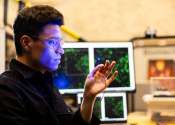Researchers develop the first-ever ingestible electroceutical device to control appetite by hormone modulation
A team of researchers at NYU Abu Dhabi (NYUAD), led by Khalil Ramadi, assistant professor of bioengineering at NYU Tandon and the Director of the Laboratory for Advanced Neuroengineering and Translational Medicine at NYU ...
Apr 26, 2023
0
103









